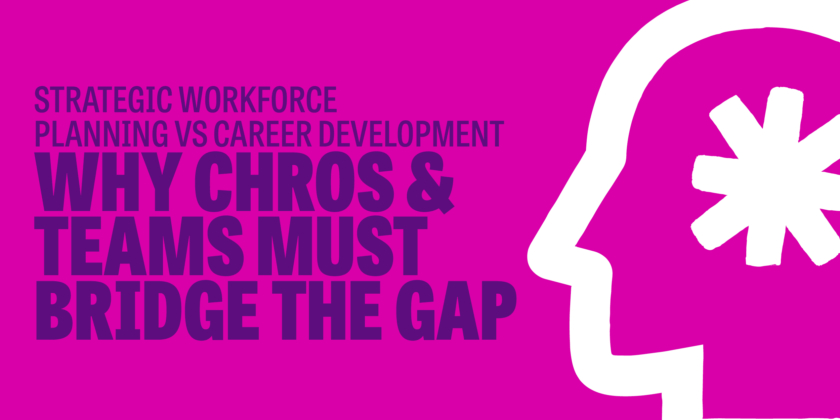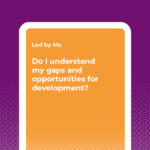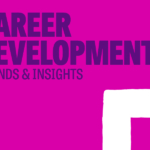In today’s rapidly evolving business landscape, Chief Human Resources Officers (CHROs) face a critical balancing act: addressing organisational talent needs while meeting individual career aspirations. This intersection between strategic workforce planning and career development represents one of the most significant opportunities for CHROs to demonstrate strategic value.
The Dual Imperatives of Talent Strategy
Strategic workforce planning and career development often operate as two sides of the same talent coin:
- Strategic workforce planning is fundamentally organisation-led, focusing on ensuring the right skills and capabilities are available when and where needed to execute business strategy.
- Strategic career development is primarily employee-led, centred on providing pathways for growth, learning, and advancement that align with individual aspirations.
The most successful CHROs recognise that these approaches are not in opposition but are complementary forces that, when aligned, create powerful talent ecosystems.
Why CHROs Must Lead This Integration
As the executive responsible for talent strategy, CHROs are uniquely positioned to bridge these two domains. The business benefits are substantial:
- Reduced talent acquisition costs through internal mobility
- Improved retention of high-potential talent
- Enhanced organisational agility to respond to market changes
- Stronger employer brand and talent attraction
- Accelerated skills development aligned with future needs
Recent research from Deloitte finds that organisations with integrated talent and business strategies are 2.5 times more likely to be high-performing than those with disconnected approaches.
Creating a Framework for Integration
For CHROs looking to lead this integration, we recommend a three-phase approach:
1. Insight Development
Begin by establishing a robust foundation of data and insights:
- Conduct skills inventories across your organisation
- Map current career paths and identify gaps
- Analyse external market trends and future skill demands
- Gather employee career aspiration data
- Identify critical roles and capabilities
2. Strategy Alignment
Next, ensure alignment between organisational needs and individual aspirations:
- Develop clear skills taxonomies that link to both business strategy and career progression
- Create visibility into future organisational capabilities required
- Design career development frameworks that reflect both business priorities and employee interests
- Establish governance mechanisms for talent management decisions
3. Implementation and Infrastructure
Finally, build the systems and practices that support the integrated approach:
- Implement technology solutions that enable skills visibility and career pathing
- Train managers in career conversations that balance organisational and individual needs
- Create talent marketplaces that facilitate internal mobility
- Establish metrics that measure both organisational capability building and employee career satisfaction
Best Practices from Leading Organisations
Forward-thinking CHROs are using integrated talent strategies to bridge workforce planning and career development. These strategies not only empower individuals to grow but also ensure organisations are building the right capabilities to meet future demands.
Transparent Career Architecture
UK-based Monzo Bank has made its progression frameworks publicly available, showing clear paths for advancement across different functions. This transparency enables employees to proactively plan their development while allowing the organisation to forecast future skills supply and ensure alignment with long-term business strategy — a core element of strategic workforce planning.
Similarly, Octopus Energy’s “Skills Passport” allows employees to develop and track competencies across different business areas. This not only supports career mobility but also gives leadership visibility into current and emerging capability gaps, enabling smarter workforce planning and succession strategies.
Skills-Based Talent Management
Moonpig’s shift to a skills-based framework helps employees explore multiple career paths while giving HR a clearer view of skill clusters within the organisation. This data informs build vs. buy decisions and helps reduce dependency on external hiring for key roles — a critical SWP function.
At Innocent Drinks, cross-functional development programs prioritise capability building across business areas. This approach supports strategic workforce planning by creating a more versatile and resilient talent pool aligned to future organisational needs.
Agile Talent Deployment
Bulb Energy has adopted a capability-focused model that moves away from rigid job titles. This supports dynamic resource planning, enabling the organisation to reallocate talent in line with evolving business priorities — a hallmark of strategic workforce agility.
Gymshark’s “Side Hustle” initiative encourages skill-building through internal projects. These initiatives provide insight into emerging internal talent pools and help inform longer-term workforce development strategies.
Technology-Enabled Career Pathways
Simply Business uses an internal talent marketplace to match employees with projects based on skills and business needs. This not only accelerates development but also supports scenario-based workforce planning by allowing leadership to model skills availability across different functions.
FDM Group’s career transition programmes use data to map technical and leadership pathways. This dual focus supports both employee mobility and strategic forecasting of organisational capability needs — connecting individual career journeys with enterprise-wide talent strategy.
| Organisation | Practice | Strategic Workforce Planning | Career Development |
| Monzo Bank | Transparent progression frameworks | Forecasts future capability needs, links roles to strategic priorities | Empowers employees with clarity on growth paths |
| Octopus Energy | “Skills Passport” | Maps current and future skill gaps across business areas | Helps individuals track and build relevant competencies |
| Moonpig | Skills-based career framework | Reduces reliance on external hiring by surfacing internal capability | Enables multiple personalised career paths |
| Innocent Drinks | Cross-functional development programme | Builds organisational bench strength in key areas | Promotes horizontal and vertical skills development |
| Bulb Energy | Agile talent deployment (capability-based model) | Supports dynamic workforce allocation aligned to strategic shifts | Allows employees to pivot and explore new roles based on capabilities |
| Gymshark | “Side Hustle” internal projects | Surfaces emerging skills for future workforce planning | Fosters a culture of continuous learning and skill exploration |
| Simply Business | Internal talent marketplace | Enables scenario planning and skills-based project allocation | Matches people to roles aligned with their aspirations |
| FDM Group | Data-driven career transition programmes | Aligns leadership and technical paths with future capability requirements | Helps employees visualise and plan long-term career progression |
Challenges and Considerations
This integrated approach is not without challenges. CHROs must navigate:
- Balancing short-term talent needs with long-term development
- Addressing varying career aspirations across generational cohorts
- Ensuring equity in access to career development opportunities
- Managing the natural tension between business agility and career stability
Measuring Success
To demonstrate the value of this integrated approach, CHROs should track metrics that reflect both organisational and individual outcomes:
- Internal mobility rates
- Time-to-proficiency in critical roles
- Employee career satisfaction
- Bench strength for key positions
- Skills acquisition aligned to strategic priorities
- Retention of high-potential talent
The CHRO as Strategic Orchestra Conductor
The most effective CHROs operate as orchestrators, bringing together multiple stakeholders—line managers, employees, L&D professionals, and executive leadership—to create harmony between organisational requirements and individual aspirations.
In this role, CHROs must be both strategic visionaries and practical implementers, able to translate business strategy into talent implications while building the infrastructure that enables career development at scale.
By successfully integrating strategic workforce planning and career development, CHROs can position their organisations for sustainable success while helping employees build meaningful careers in an era of unprecedented change.
How Let’s Talk Talent Can Help
At Let’s Talk Talent, we specialise in helping CHROs and HR leaders design and implement integrated talent strategies that balance organisational needs with individual aspirations. Our expertise includes:
- Strategic Workforce Planning – We help organisations translate business strategy into talent implications and create actionable workforce plans
- Career Framework Development – Our team designs career architectures that create clarity, transparency, and development opportunities
- Manager Capability Building – We equip leaders with the skills to have meaningful career conversations
- Talent Strategy Alignment – We ensure your talent approaches are aligned with both business goals and employee expectations
Ready to Transform Your Approach to Strategic Career Development?
Our team of experienced talent consultants is ready to help you navigate the complex intersection of strategic workforce planning and career development.
Book a complimentary consultation: Schedule a 30-minute discussion with one of our senior consultants to explore how we can support your specific talent challenges.
Download our Strategic Workforce Planning Template: Start your journey with our practical planning tool designed for HR leaders.
This article was produced by Let’s Talk Talent, a leading talent management and organisational development consultancy supporting HR leaders across the UK and globally.



